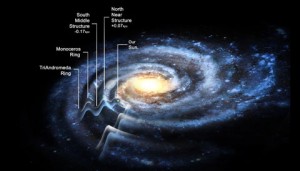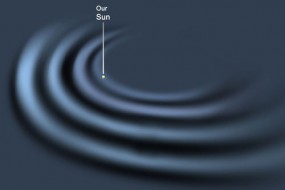Astronomers have detected what look like four undulations in the Milky Way Galaxy’s disk. If the structures are all part of the disk, our galaxy is more than half again as large as we thought it was.
When you think of our Milky Way Galaxy, you might imagine a smooth disk with spiral arms embedded in it, like swirls in a peppermint. But a second look at observations from the Sloan Digital Sky Survey (SDSS) suggests that our galaxy’s disk is actually corrugated.

Dana Berry
In 2002, Heidi Newberg (Rensselaer Polytechnic Institute) and colleagues found several clumps in the density of stars at the disk’s outermost edge, a clumpy structure now called the Monoceros Ring. Looking out along the disk with the galactic center behind us, we see the structure 30,000 light-years from the Sun, meaning it’s roughly 60,000 light-years from the galactic center. (The Sun is about halfway between the galactic center and the disk’s presumed edge.)
Other astronomers later found another structure, called the Triangulum Andromeda Stream, beyond the Monoceros Ring. This one seems to lie something like 80,000 light-years from the galactic center, beyond where we think the disk ends.
Debate has blossomed over the past decade about what these clumps of stars are. Many argue that they’re stuff nabbed from dwarf galaxies that came too close to the Milky Way. Others say that the Monoceros Ring is merely the disk flaring at its edges. (The authors of the new paper have a detailed discussion of the debate in their introduction, which I recommend reading.)
Now, Yan Xu (now of the National Astronomical Observatories of China), Newberg, and colleagues have returned to the 2002 SDSS observations to look at an additional hint of structure that didn’t seem to belong to either of these.
The astronomers used stars’ true magnitudes to determine how far away the stars had to be in order to look as faint as they do (and accounting for all the dust between us and them). Oddly, they found four separate structures: two of them the Monoceros and Triangulum Andromeda ones, plus two more lying between us and Monoceros. The closest is about 6,000 light-years out from the Sun, with each subsequent structure lying roughly 6,000 light-years beyond the previous one, almost like evenly spaced lumps.

Dana Berry
But the lumps aren’t smack in the plane of the disk, all lined up like the swirls in the peppermint. Instead, they are above, then below, then above, then below, like the ripples in corrugated cardboard. The two inner structures actually seem to line up with the Perseus (closer) and Outer Arms, although they’re on the opposite sides of the midplane from those two arms — for example, the closest concentration is “north” of the midplane but the Perseus Arm is slightly “south.” That suggests there’s also a vertical ripple in the Milky Way’s disk, not just one moving outward.
The two types of ripples look like the waves a dwarf galaxy would create if it passed through the Milky Way’s disk, according to computer simulations by various teams. For example, Sukanya Chakrabarti (Rochester Institute of Technology) and Leo Blitz (University of California, Berkeley) saw structures like the Monoceros Ring in their simulations in 2009 when checking to see whether a dwarf galaxy encounter might explain why the Milky Way's gas disk looks a bit perturbed. Chakrabarti agrees that the ripples Xu's team found are likely real, but she says it’s hard to know what caused them, at least without more simulation work. The outer two are most likely from a dwarf galaxy encounter, but it’s unclear whether dynamics inside the Milky Way could explain the two closer ones.
A satellite galaxy passing through the disk might also explain the substructure within both the Monoceros and Triangulum Andromeda features, Newberg says. And while she doesn’t yet understand the connection between the Milky Way’s spiral arms (which are full of young, massive stars) and these ripples (which aren’t), both could be triggered by a dwarf passing through the galaxy’s disk.
If the Monoceros Ring and the Triangulum Andromeda Stream are part of the disk, that would mean that the Milky Way’s pancake is something like 60% larger than we thought it was. Instead of extending nearly 100,000 light-years from one side to the other, it would be more like 160,000 light-years wide, on par with the Andromeda Galaxy, the other large spiral in our Local Group of galaxies.
The team has also posted a 20-minute video explaining the findings for the general public, and a 50-minute video with more detail. You can find both at the end of the Rensselaer press release.
References: Y. Xu et al. “Rings and Radial Waves in the Disk of the Milky Way.” Astrophysical Journal. March 10, 2015.
 5
5
Comments
Joe Slomka
March 18, 2015 at 7:35 pm
Camille,
Dr. Heidi Newberg is Chairwoman of the Dudley Observatory Board.
I work with her on the board and have attended her lectures.
Nice to see her and RPI given credit.
You must be logged in to post a comment.
ROBERT STENTON
March 20, 2015 at 6:18 pm
If the ripples are undulating as would be the case if caused by an object that passed through the galactic plane, then the material in the galactic plane would alternate between being compressed and being expanded. This in turn would create new stars during the compressive phase which may be why the arms of the Milky Way seem to follow these waves. If this is so, by dating the age of the newer stars, the date of compressions could be determined and with that it should be possible to determine the rate of movement of the undulations.
You must be logged in to post a comment.
Jim-Baughman
March 22, 2015 at 9:57 pm
I don't think that these galactic waves can both undulate up and down and compress at the same time. The ripples on the surface of a pond disturbed by a pebble don't have more water molecules at the top of the trough and fewer at the bottom. However sound waves travelling through air do in fact compress the air molecules because otherwise the energy has no other way to express itself. The galactic wave models the pond-ripple rather than the acoustic one.
You must be logged in to post a comment.
March 20, 2015 at 8:52 pm
I'd always heard/thought the spirals were standing gravitational waves where gravity compressed gas and dust into star forming regions vs regions of rarefaction.
You must be logged in to post a comment.
Paul
March 23, 2015 at 3:40 pm
Fascinating. This one got me thinking about the density wave theory, too.
You must be logged in to post a comment.
You must be logged in to post a comment.